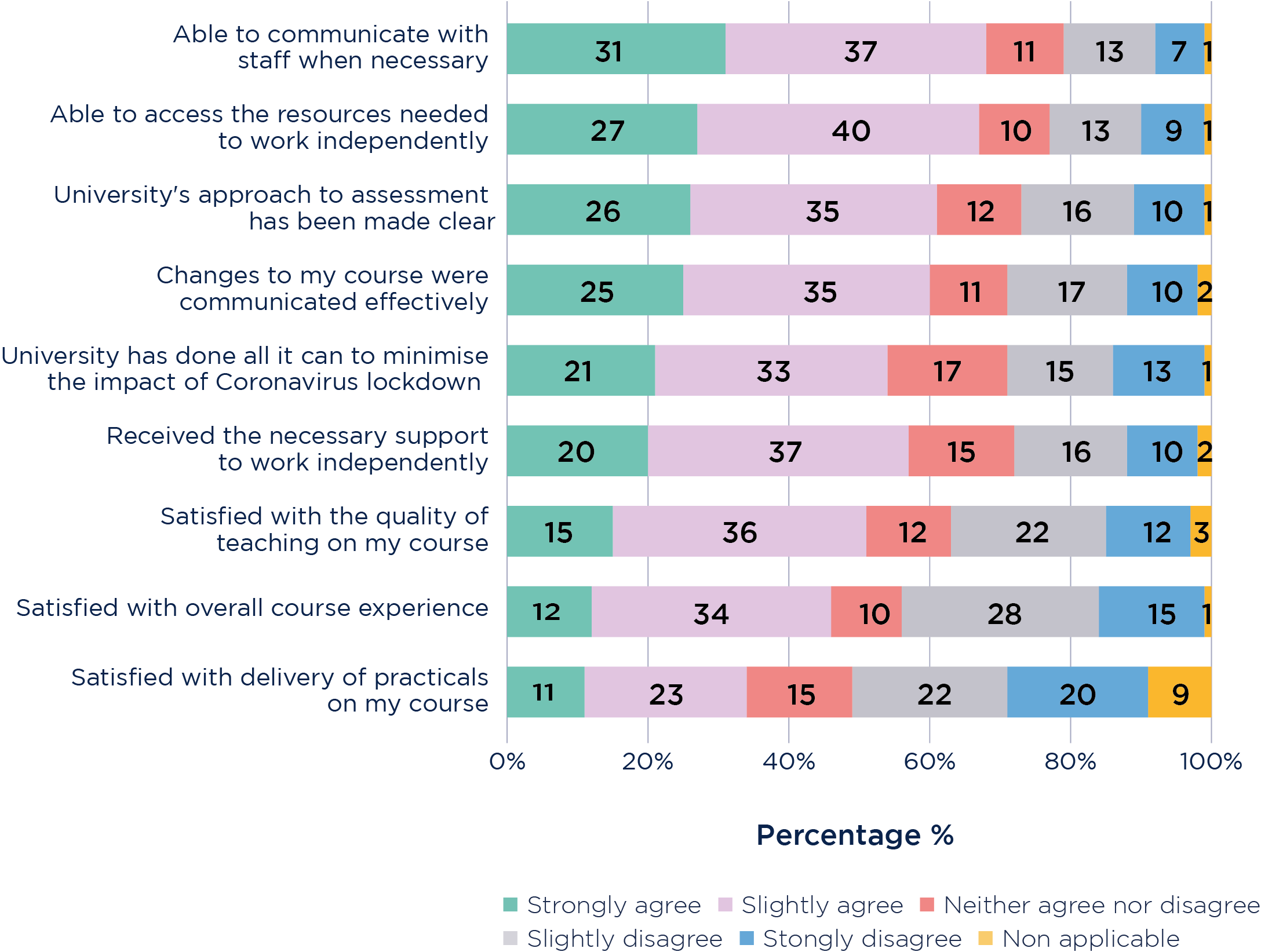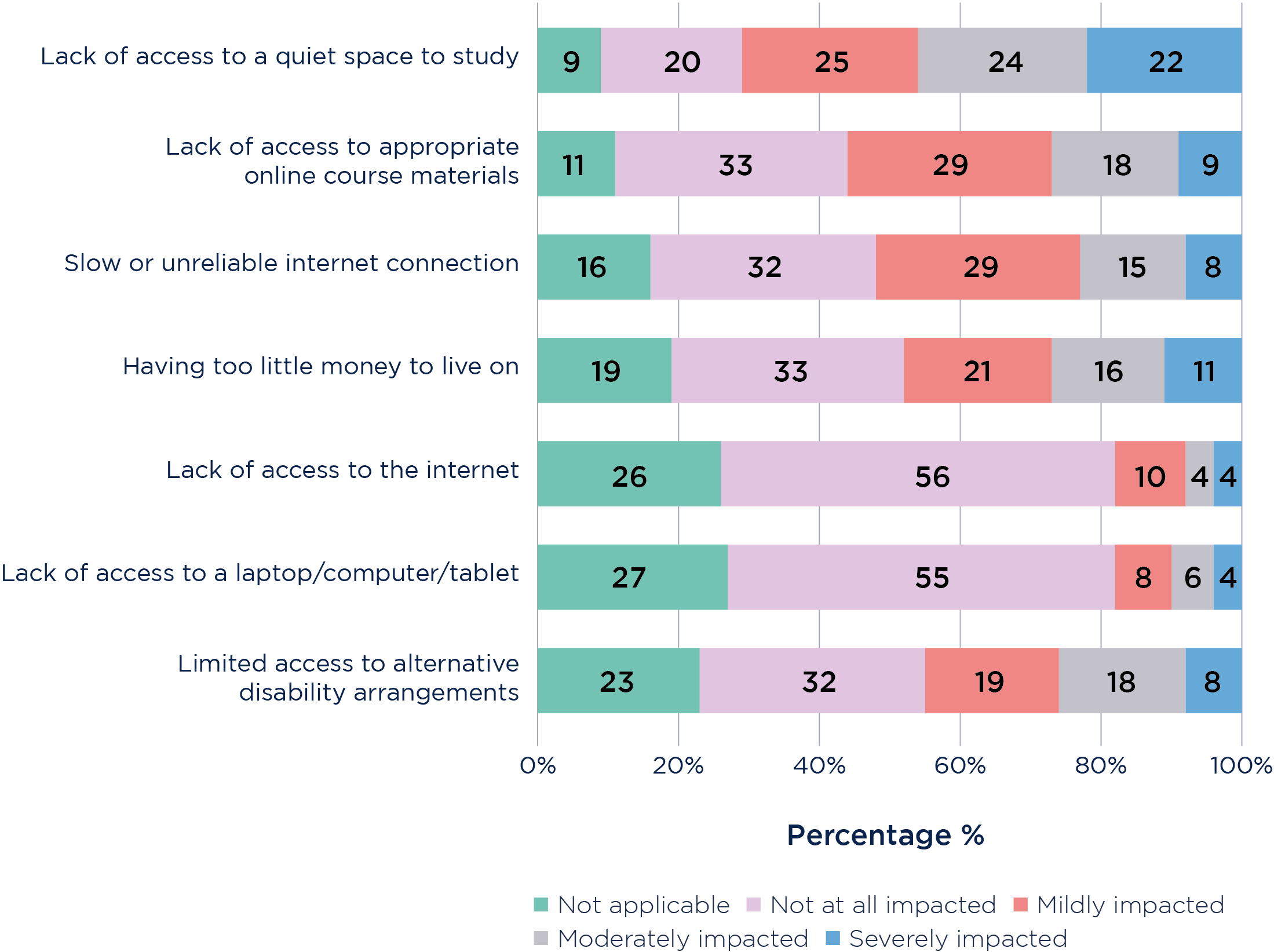The ability of students to participate in higher education from home is being disrupted by a lack of access to core digital infrastructure, new survey data published by the Office for Students (OfS) shows today, as a major new review into digital teaching and learning is launched.

During the coronavirus (COVID-19) lockdown, 52 per cent of students said their learning was impacted by slow or unreliable internet connection, with 8 per cent ‘severely’ affected. According to the poll of 1,416 students, run for the OfS by Natives:
- 71 per cent reported lack of access to a quiet study space, with 22 per cent ‘severely’ impacted
- 56 per cent said they lacked access to appropriate online course materials, with 9 per cent ‘severely’ impacted
- 18 per cent were impacted by lack of access to a computer, laptop or tablet – 4 per cent said they were ‘severely’ impacted.
The findings come as OfS chair, Sir Michael Barber, launches a major review of digital teaching and learning in English higher education today. Examining the relationship between digital poverty and students’ academic experience is one area of the review.
The review will also consider how digital technology has been used to deliver remote education since the pandemic started; how high-quality digital teaching and learning can be delivered at scale in the future; and the opportunities that digital education presents for universities in medium and long term. It will draw on examples of successful online teaching from the UK and overseas, particularly in the lockdown.
Sir Michael Barber, chair of the Office for Students, said:
'Since the beginning of the pandemic universities have been working hard to deliver high-quality education in extremely difficult circumstances – I’ve have been repeatedly impressed by their innovation and ingenuity. Likewise, students have shown great flexibility and dedication to their studies throughout.
'With this unprecedented disruption comes an opportunity. In a short space of time many universities and colleges have significantly developed the digital teaching and learning options they offer students. It is critical that we build on this progress – identifying what has worked well in recent months, what methods could be enhanced further, and identifying long-term opportunities for innovation that will benefit generations of students into the future.
'However, it is no use making these strides if there are students who cannot access digital resources effectively. As today’s polling shows, there remain a significant number of students whose access to remote education is being disrupted – sometimes severely – by poor access to core digital infrastructure. And there remains critical progress to be made in closing persistent gaps in broadband speeds between urban and rural areas.
'Improving equality of opportunity for students from all backgrounds is central to our work. We have already set universities and colleges ambitious targets on improving access for disadvantaged students and progress is being made. But as digital teaching and learning is increasingly embedded in higher education, we cannot risk students being left behind in the rush for online innovation. That is why I have put an examination of the impact of digital poverty at the heart of this review and will ensure that the recommendations we make will have student access at their core.'
The OfS has published a call for evidence seeking responses from those involved in the delivery and design of digital teaching and learning, such as teachers and administrators, as well as students' unions. Information received from the call for evidence will help inform the recommendations of the digital teaching and learning review and to identify case studies.
Today’s student polling also asked students about their general perceptions of how successfully their courses were delivered during the pandemic. It showed that 51 per cent of students said that they were satisfied with the quality of their teaching during the pandemic, compared with 34 per cent dissatisfied. Students who reported having live online lectures tended to view their teaching more positively than those taught with old recorded lectures or written slides. Other areas of the survey showed that:
- 68 per cent of students agreed that they were able to communicate with staff when necessary, compared to 19 per cent who disagreed
- 61 per cent agreed that their university’s approach to assessment has been made clear, compared to 26 per cent who disagreed
- 60 per cent agreed that changes to their course were communicated effectively, compared to 28 per cent who disagreed
- 46 per cent of students were satisfied with their overall course experience, compared to 43 per cent dissatisfied.
In April, the OfS released guidance on maintaining quality and standards during the pandemic. It said that universities and colleges should make all reasonable efforts to provide teaching and support for students that is broadly equivalent to normal arrangements and consider how online teaching can be used to deliver existing courses. Universities should also assess students’ achievement reliably but flexibly and provide clear communications to students.
Case studies
Universities, colleges and others have adapted their teaching for digital delivery during the pandemic. The following examples have been developed at pace and are offered in the spirit of sharing practice that others may find useful and applicable to their own contexts:
- Geoscientists at Imperial College London have completed the UK’s first MSc virtual field trip.
- The University of the Arts London (UAL) developed an extensive online platform to show and celebrate students’ work in the summer, instead of a physical show.
- The University of Exeter’s Researcher Development and Research Culture team expanded its existing webinar programme to include additional sessions on topics such as writing, wellbeing and project management to provide guidance and support on continuing postgraduate research remotely.
For more information please contact Richard Foord on 0117 905 7676 or email [email protected].
Notes
- The digital teaching and learning review is not intended to gather information for regulatory purposes. Notification of any matters that may be of regulatory interest to us should not be submitted through this call for evidence. Further information about notifications is available on our website.
- The review proposes that a student is in ‘digital poverty’ if they are without access to one of the core items of digital infrastructure, which are:
– appropriate hardware
– appropriate software
– reliable access to the internet
– technical support and repair when required
– a trained teacher or instructor
– an appropriate study space. - According to Ofcom the download speed necessary for a decent broadband service which enables full participation in a digital society is 10 Mbit/s. Their research shows that in November 2019 over one-fifth (22 per cent) of consumer panellists in rural areas of the UK received an average 24-hour download speed of less than this. This proportion was higher than for the UK as a whole (12 per cent) and the proportion in urban areas (10 per cent). Ofcom’s Connected Nations update: Spring 2020 also shows that superfast broadband services were available to 98 per cent of urban premises in January 2020, compared to 80 per cent of rural areas.
- Students’ perceptions of the impact of the coronavirus lockdown on teaching, learning and assessment:


Please note: Care should be taken in interpreting Figure 2 due to the large number of students who have selected not applicable for some questions. Students may have selected this for a variety of reasons. We have focussed on reporting proportions of the relevant population who experienced issues but recognise that this may understate the extent of those issues for students who had not needed to use certain facilities, for example quiet spaces, for study since the start of lockdown.
